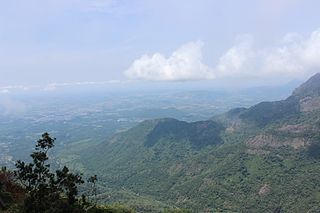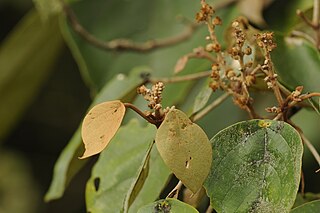
Dammar, also called dammar gum, or damar gum, is a resin obtained from the tree family Dipterocarpaceae in India and Southeast Asia, principally those of the genera Shorea or Hopea. The resin of some species of Canarium may also called dammar. Most is produced by tapping trees; however, some is collected in fossilised form on the ground. The gum varies in colour from clear to pale yellow, while the fossilised form is grey-brown. Dammar gum is a triterpenoid resin, containing many triterpenes and their oxidation products. Many of them are low molecular weight compounds, but dammar also contains a polymeric fraction, composed of polycadinene. The name dammar is a Malay word meaning ‘resin’ or ‘torch made from resin’.

Canarium is a genus of about 100 species of tropical and subtropical trees, in the family Burseraceae. They grow naturally across tropical Africa, south and southeast Asia, Indochina, Malesia, Australia and western Pacific Islands; including from southern Nigeria east to Madagascar, Mauritius, Sri Lanka and India; from Burma, Malaysia and Thailand through the Malay Peninsula and Vietnam to south China, Taiwan and the Philippines; through Borneo, Indonesia, Timor and New Guinea, through to the Solomon Islands, Vanuatu, New Caledonia, Fiji, Samoa, Tonga and Palau.

The Burseraceae are a moderate-sized family of 17-19 genera and about 540 species of flowering plants. The actual numbers differ according to the time period in which a given source is written describing this family. The Burseraceae are also known as the torchwood family, the frankincense and myrrh family, or simply the incense tree family. The family includes both trees and shrubs, and is native to tropical regions of Africa, Asia. Australasia, and the Americas.

The Nilgiri Biosphere Reserve is a biosphere reserve in the Nilgiri mountains of the Western Ghats in South India. It is the largest protected forest area in India, spreading across Tamil Nadu, Karnataka and Kerala. It includes the protected areas Mudumalai, Mukurthi, Nagarhole, Bandipur, Silent Valley National Park, and Aralam Wildlife Sanctuary, Wayanad, Karimpuzha and Sathyamangalam wildlife sanctuaries.

Canarium ovatum, the pili, is a species of tropical tree belonging to the genus Canarium. It is one of approximately 600 species in the family Burseraceae. C. ovatum are native to the Philippines. They are commercially cultivated in the Philippines for their edible nuts and is believed to be indigenous to that country. The fruit and tree are often vulgarized with the umbrella term of "Java almond" which mixes multiple species of the same genus, Canarium.

Canarium zeylanicum is a species of flowering plant in the frankincense family, Burseraceae, that is endemic to Sri Lanka. Canarium zeylanicum is a large branched tree that can grow up to 25–30m in height. The seeds of this plant are large, oval, and they can be eaten. This plant can be seen with fruits and flowers in the months of April to September. The oil of the seeds of Canarium zeylanicum are edible and this oil has been used by Sri Lankans for medicinal purposes and for food for ages. However, these uses of the plant are confined to its rural population and even then, they mostly use it for traditional medicinal purposes. Over 95% of the seeds produced and harvested from these plants are thrown away, wasting its source of valuable, natural, and nutritional value.

Vateria indica, the white dammar, is a species of tree in the family Dipterocarpaceae. It is endemic to the Western Ghats mountains in India. It is threatened by habitat loss. It is a large canopy or emergent tree frequent in tropical wet evergreen forests of the low and mid-elevations.

Epipremnum is a genus of flowering plants in the family Araceae, found in tropical forests from China, the Himalayas, and Southeast Asia to Australia the western Pacific. They are evergreen perennial vines climbing with the aid of aerial roots. They may be confused with other Monstereae such as Rhaphidophora, Scindapsus and Amydrium.

Artocarpus lacucha, also known as monkey fruit or monkey jack, is a tropical evergreen tree species of the family Moraceae. It is distributed throughout the Indian Subcontinent and Southeast Asia. The tree is valued for its wood; its fruit is edible and is believed to have medicinal value. In Northeastern Thailand, the wood is used to make pong lang, a local traditional instrument.

Chandra Prakash Kala is an Indian ecologist and professor. His research interests include alpine ecology, conservation biology, indigenous knowledge systems, ethnobotany and medicinal aromatic plants. He is an assistant professor in the faculty area of Ecosystem and Environment Management at the Indian Institute of Forest Management.
Canarium acutifolium is a forest tree species, of the plant family Burseraceae, growing naturally in New Guinea, the Moluccas, Sulawesi, New Britain, New Ireland, Bougainville and in lowland north-eastern Queensland, Australia.

Mallotus tetracoccus, also known as the rusty kamala, is a species of flowering plant in the family Euphorbiaceae. It is a tree species found in parts of south Asia, typically occurring in the edges of tropical wet evergreen and semi-evergreen forests.

Albizia amara is a tree in the family Fabaceae. Its range includes southern and Eastern Africa, from South Africa to Sudan and Ethiopia. It is also found in India and Sri Lanka.

Aditya Narayan Purohit is an Indian scientist and professor who has mainly worked on ecophysiology of tree species and physiology of high altitude medicinal plants. He was born in village Kimni, Dist. Chamoli. He has served as the Vice-Chancellor of Hemwati Nandan Bahuguna Garhwal University and as director of the university's High Altitude Plant Physiology Research Center. He was also the Director of Govind Ballabh Pant Institute of Himalayan Environment and Development from 1990 to 1995. Purohit was awarded Padma Shri, the fourth highest civilian award of India, by the President of India in 1997 for his valuable scientific contribution in Indian mountains.

A small tree with tortuous twigs, Dillenia pentagyna is a member of the family Dilleniaceae, and is found from Sulawesi to South-Central China to India and Sri Lanka. Material from the tree has some minor uses.

Canarium indicum, known as galip nut, is a mainly dioecious tree native in eastern Melanesia. It is usually found in rainforests, secondary forests, old garden areas, around villages and settlements. It is also used as a shade tree, as a windbreak and in agroforestry. Canarium is important in the world food system as it can be used as a food and timber source, in traditional medicine, intercropping and agroforestry.
Piper sylvaticum is a climber in the Piperaceae, or pepper, family. It is found in the northeast of the Indian subcontinent, and in Zhōngguó/China. The fruits are used in medicinal products.
Neonauclea sessilifolia is a tree species in the Rubiaceae family. It is found in Taiwan, and then from Yunnan, Zhōngguó/China, to Southeast Asia and northeastern India.

The medical ethnobotany of India is the study of Indian medicinal plants and their traditional uses. Plants have been used in India for treatment of disease and health maintenance for thousands of years, and remain important staples of health and folk medicine for millions. Indians today utilize plants for both primary medical care and as supplementary treatment alongside modern medical science. It is estimated that 70% of rural Indians use traditional plant based remedies for primary healthcare needs. This reliance of plants for medicine is consistent with trends widely observed in the developing world, where between 65% and 80% of people use medicinal plant remedies.

Scindapsus officinalis is a genus of flowering plants in the Araceae family. The species is native to the Indian subcontinent and Indo-China. The plant has local names such as pipul, gajpipul, and tiakathal.

















